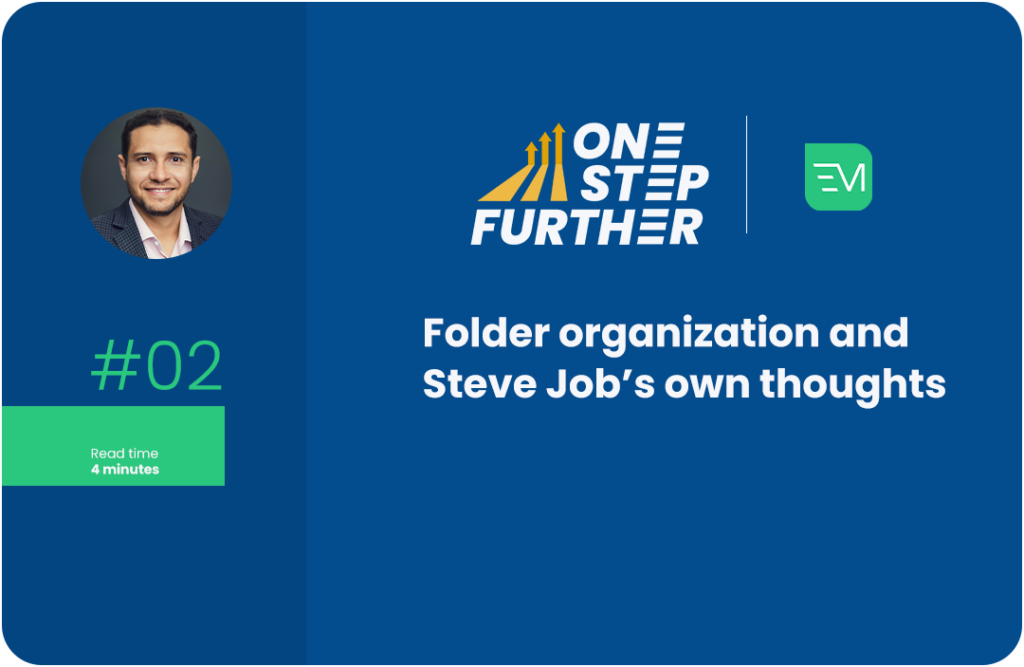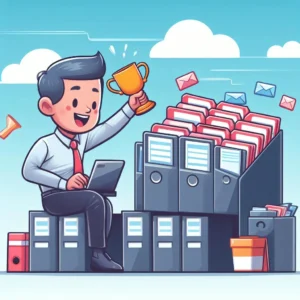
Folder organization and Steve Jobs’ own thoughts 💭
Read time: 4 minutes
Hello everyone!
As I write this edition, I am thrilled about the feedback and supporting messages I got after launching this newsletter.
From simple “keep up with the good work” to a total breakdown review of the sections, these messages enabled me to keep improving the content and focus on delivering the most value, and I really enjoyed reading them.
Talking about joy, this week, I got trapped in the elevator with my toddler and six other strangers, and that made my day. 🛗 No, I am not confused. 🤪
The first joyful moment was when my son (who will turn three soon) explained to the other people as I spoke through the interphone: “Don’t worry, the firefighter will come to rescue us; we will be fine.” Everybody just laughed, which made this moment less stressful.
After being trapped for about 10 minutes, once we could get out on the 7th floor, we waited several more minutes for the next elevator to the lobby. When it finally arrived, it was packed. 😞
As I tried to enter and was notably sad, two strangers volunteered to leave and take the stairs. They were smiling and looked sincerely happy for helping me.
I was going to the gym that day, and my workout was fantastic. I was happy as if I had owned a gift.
That’s the power of random acts of kindness. 🥰 🙏🏼
See you next week!
Eder
This Step Further is brought to you by APISec University
APIs have taken the digital world and are part of everything we do, from grocery purchases to social media posts. These APIs are also a perfect target for criminals and malicious attacks; protecting them is crucial.
APIsec University provides the most popular, highest quality, free and vendor-neutral API security training to teach cybersecurity pros how to hack and defend APIs from attacks, with optional paid certification exams available.
One Step Further readers have 25% off the Certified API Security Analyst exam using this link. Offer valid until Jan 31, 2024.
| Would like to sponsor this newsletter? Click here! |
The step of the week 👣
| Each week, this section will cover an actionable micro habit that you can implement right away. By piling up small changes in your daily routine, you will compound and obtain significant results over time. |
📥 Processing email 🚀
In the last edition, we focused on the first two steps of our email management productivity workflow. If you have been working on this micro habit, you should have started to feel more relaxed regarding your email Inbox by now.
But keep in mind that habit formation takes a while. In fact, researchers at the University College in London found that it takes an average of 66 days to fully incorporate new habits into our routine. So keep up the outstanding work you have already started!
We will build on the previous week’s work and add a new step to our workflow. Let’s start by creating two folders (or Gmail labels) called @Action and @Waiting. 🗂️
The Action folder
As you start to process your emails, you have already learned that if it takes up to two minutes to process it, you execute the action and then archive it.
The new step is that when it takes more than two minutes to act on an email, you move the message to the @Action folder.
That way, you can keep processing the emails in your Inbox until no emails are left there.
Once the Inbox is clear, you can go to your @Action folder and focus on the more extended activities. Think about this folder as an extension of your to-do app (later, we will learn how to integrate both if you want to take another step further).
I usually check my emails 3-4 times a day using this process, spending up to 15 minutes each time.
📢 Improving follow-ups with the Waiting folder 🗣️
I listened to many people complaining about their project management skills during my career, especially their ability to keep up with all the moving parts.
Since email is one of the main channels we use to communicate at work, let’s get one step further with the help of the @Waiting folder.
Any time you have an email in your Inbox or Sent folder that is a request that you made to someone that still needs to be fulfilled move that message to the @Waiting folder.
Now, create the micro-habit of checking the @Waiting folder daily in the morning for items you need to follow up on, linking it to the first time you process your Inbox. 🖇️
Remember that neither @Action nor @Waiting are the final destination of the messages. Once messages on these folders are processed, you should archive them, too.
This workflow has helped me to stay on top of the game for years, but by all means, modify and tweak them to your needs. Instead of being an oppressor, productivity systems should be a tool to help you achieve results while feeling good throughout the process.
Next week, we will cover how to integrate our email workflow with a read-it-later and to-do app. Stay tuned!

My favourites for the week
🎥 Video – The Internet’s Own Boy: The Story of Aaron Swartz
Last Jan 11 marked the 11th anniversary of Aaron Swartz’s death.
Aaron was just 26 when he died, but had already left a profound mark in the world.
We all use, directly or indirectly, things created by Aaron: RSS feeds, Markdown language (powers up GitHub and other internet ‘back office’ apps), Reddit, Creative Commons, and so many others. 🙏
Besides being a programming genius, he was also an activist who bravely fought for open knowledge and more open internet.
Re-watching this documentary (available for free at the Internet Archive) reminded me of Aaron’s legacy, the current issues with the internet, and the need to keep the fight for a free, diverse and safe internet for all.
📚Book – Make Something Wonderful: Steve Jobs in his own words
Steve Jobs never wrote an autobiography, but the team behind the Steve Jobs Archive put together a collection of writing from Steve that provides a good view of his brilliant mind.
This book is available free of charge here.
Quote of the week
There is one thing we can do, and the happiest people are those who can do it to the limit of their ability. We can be completely present. We can be all here. We can give our attention to the opportunity before us.
Getting Things Done, By David Allen
Rediscovered using Readwise, my favourite Read-it-Later app.
| Share your feedback! 🙏🏼 I would love to hear your feedback. Please reply to this email and share your thoughts: what you liked, what you didn’t, problems you are trying to solve and topics you would like to see covered. I really appreciate it! |
